In a quiet week for domestic data, attention instead focussed on the unfolding turmoil in global banking markets, the consequences for the US Federal Reserve’s policy decision this week and any implications of both of these for the RBA’s own 4 April monetary policy meeting.
More specifically, the big debate has been over whether – when confronted by rising financial stability risks – the Fed would blink in its anti-inflation fight by pausing or even halting the rate hike cycle and if so, whether the RBA would follow. In the end, the Federal Open Markets Committee (FOMC) opted for a compromise solution that was largely in line with financial market expectations. It decided not to go ahead with the 50bp rate hike that it had been considering before the failure at Silicon Valley Bank two weeks ago, but it also decided not to pause the monetary policy tightening cycle. Instead, the FOMC announced a 25bp increase in the target range for the fed funds rate, taking it to 4.75 – 5.0 per cent. That marked a ninth consecutive rate increase from the Fed and took the policy rate to its highest level since September 2007.
With the ECB also having decided to hike its key policy rates by 50bp on 16 March, two of the world’s leading central banks have just indicated that – for now at least – they do not view current levels of financial stress as sufficiently worrying to warrant a monetary policy pause. The Fed did imply, however, that it might now be close to the end of its tightening cycle. That leaves Martin Place with another week and a bit to assess whether its US and European counterparts have made the right call before it has to make its own choice.
This week on The Dismal Science podcast, we cover the shaky financial system, the Fed rate hike and the collapse of Credit Suisse.
The Fed balances inflation and financial stability risks
When speaking to the US Senate Banking Committee back on 7 March, US Fed Chair Jerome Powell warned that ‘the latest economic data have come in stronger than expected, which suggests that the ultimate level of interest rates is likely to be higher than previously anticipated. If the totality of the data were to indicate that faster tightening is warranted, we would be prepared to increase the pace of rate hikes.’ Financial markets took this to mean that, in order to tame stubborn underlying inflationary pressures, the US central bank was considering returning to larger (50bp) hikes at its upcoming March 2023 FOMC meeting, reversing the previous decision to slow the pace of monetary policy tightening from a 75bp increase in November 2022 to a 50bp increase in December 2022 and a 25bp rise at the first meeting of this year.
Subsequent disruption in the US banking system, with the collapse of Silvergate, Silicon Valley and Signature Banks and the consequent pressure on other institutions, followed by the dramatic failure and forced sale of Credit Suisse, therefore presented the Fed with a tricky dilemma. After having just indicated the potential need for more aggressive monetary tightening, a decision to instead hit pause on the rate cycle could be seen as evidence for ‘financial dominance’. When faced with risks to financial stability, the Fed would end up abandoning its pursuit of higher interest rates and instead shift to tolerating higher inflation. That would be bad news for the central bank’s credibility as an inflation-fighter. Yet, if the Fed continued to tighten policy regardless, that decision could be seen as wilfully and irresponsibly ignoring alarm bells sounding over the financially destabilising impact of higher interest rates. Moreover, given that the deterioration in market conditions was already generating tighter financial conditions even in the absence of a formal policy change from the Fed, the banking collapses should mean that the required magnitude of any future rate increases had declined.
This week, the FOMC chose to balance these competing inflation and financial stability risks by persisting with the current tightening cycle, but it did so at the same measured 25bp rate it had adopted at the previous meeting this year. Powell noted the FOMC did consider the proposition that a credit contraction could reduce both inflation and activity and reported that members discussed the case for a pause. But they went on to vote unanimously for the 25bp increase. In a recognition of the change in circumstances, however, the Fed did soften its rhetoric, dropping previous references to ‘ongoing increases’ in rates and thereby implying that it might be (nearly) done.
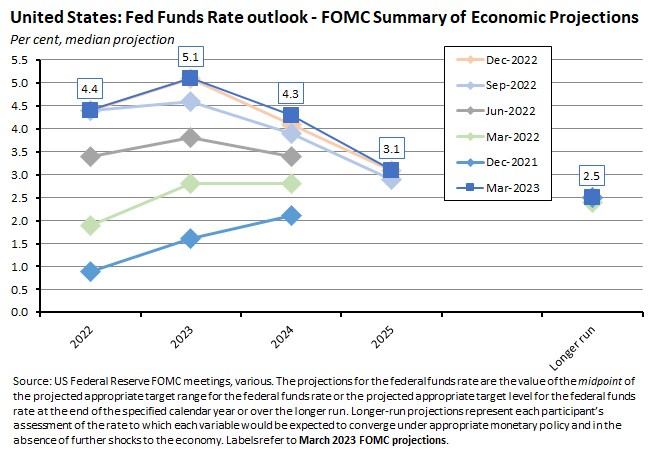
According to the March 2023 Summary of Economic Projections (SEP), FOMC members expectations for the future Fed funds rate are now little changed from the December 2022 SEP. The median projection still sees the target range peaking at 5.0-5.25 per cent this year (implying one more 25bp rate increase to come) before easing to 4.25 – 4.5 per cent in 2024 (that’s 25bp higher than the 4.0-4.25 per cent range in December) and then down to 3.0-3.25 per cent in 2025.
Which implies that in terms of the Fed’s monetary policy thinking, the main impact of the past fortnight’s developments has been to return us to the position at the end of last year.
RBA minutes set out case for (pre-SVB and Credit Suisse) data-dependent pause in April
Minutes of the RBA’s 7 March Monetary Policy Meeting refer to the situation prevailing before the recent stress on the international banking system and as such are a necessarily imperfect reflection on choices likely to face the RBA next month. Still, what they do show is that, at the time of the March meeting, members were seeking to balance two considerations.
On the one hand, they agreed that ‘inflation in Australia remained too high, the labour market was very tight and wages growth had picked up.’ And on that basis, the case for another increase in the cash rate seemed clear:
‘In light of inflation being too high and forecast to remain above target for two years, members agreed that a further tightening of monetary policy was warranted at the current meeting…Members agreed that the appropriate adjustment of interest rates was 25 basis points, the same as in preceding months.’
On the other hand, however, members also had to grapple with the fact that ‘the most important data released over the prior month – covering GDP, the labour market, wages and inflation – had all been a little softer than expected.’ The meeting discussed the extent to which this relative weakness in numbers could be interpreted as indicating that demand was weaker than the central bank had previously assumed, given that shortfalls to expectations were fairly modest and there were reasons not to put too much weight on one period’s data. Nevertheless, their discussion concluded that ‘it was appropriate to take some signal from the consistent pattern across recent data releases.’
The importance of interpreting just what current data are signalling was apparent when the focus of the discussion moved on from the March decision itself to the future outlook for the cash rate. Here, members noted that core inflation remained high, that the RBA’s own forecasts only showed inflation returning to target by mid-2025, given the assumption of a further modest increase in the cash rate, and that rates in Australia were below those in other countries, with potential implications for the exchange rate that would add to inflationary pressures. As a result, ‘further tightening of monetary policy would likely be required to ensure that inflation returns to target’. Set against these considerations was a recognition that monetary policy was now restrictive, and that the economic outlook (particularly for household consumption) was quite uncertain. As a result:
‘These considerations mean it would be appropriate at some point to hold the cash rate steady, to assess more fully the effect of the interest rate increases to date…upcoming releases on employment, inflation, retail trade and business surveys would provide important additional information, as would developments in the global economy. Members agreed to reconsider the case for a pause at the following meeting, recognising that pausing would allow additional time to reassess the outlook for the economy.’
As discussed last week, in terms of the recent data flow, taken on their own, the latest readings on employment and business conditions did not make an especially compelling case for a pause, leaving next week’s CPI and retail trade indicators as the swing factors. In addition, of course, the current deterioration in global financial conditions will also influence the RBA’s decision, as will the nature and consequences of this week’s Fed decision.
Australian monetary policy’s ‘long and variable lags’ may now be even longer
Another source of uncertainty highlighted by this week’s RBA minutes was ‘the lags in the effect of monetary policy and the cumulative impact of the significant increase in interest rates since May 2022…these lags complicate the task of assessing the outlook for the economy.’ In this context, RBA Assistant Governor (Financial Markets) Chris Kent gave a speech on long and variable monetary policy lags this week.
Kent explained there were two reasons to believe the cash flow channel of the monetary policy transmission mechanism may currently be operating more slowly than it has in the past, and that as a result, it might take longer than usual to see the full impact of tighter monetary policy on household spending.
First, the share of fixed rate mortgages was unusually high when the RBA started to tighten monetary policy in May last year – above 35 per cent vs a pre-pandemic average of closer to 20 per cent. Partly as a result, while the cash rate has risen by 350bp since May 2022, the average outstanding mortgage rate has increased by around 110bp less than that, with more than half of the difference due to the effect of fixed rate mortgages that haven’t yet rolled onto variable rates (the increase in variable rates has also been limited to about 40bp less than the cash rate increase by competition between lenders).
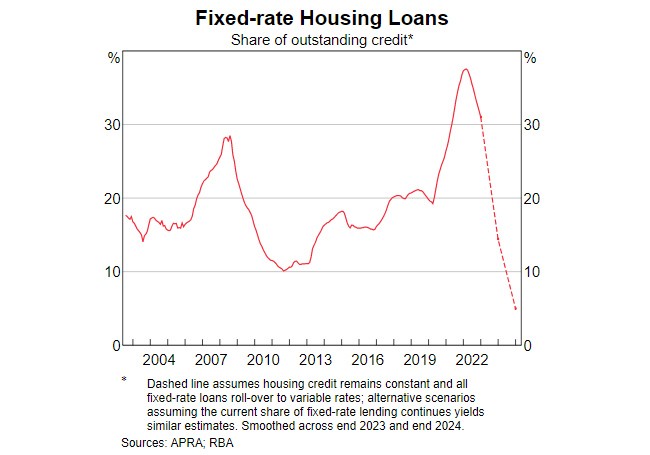
According to Kent, scheduled mortgage payments rose by about 1.1 percentage points of household disposable income over 2022. Based on the current cash rate, they will increase by a further 1.5 percentage points by end-2024, with most of that increase having occurred by end-2023. In other words, only about 45 per cent of the rise in the cash rate to date had passed through to scheduled mortgage payments by the end of last year.
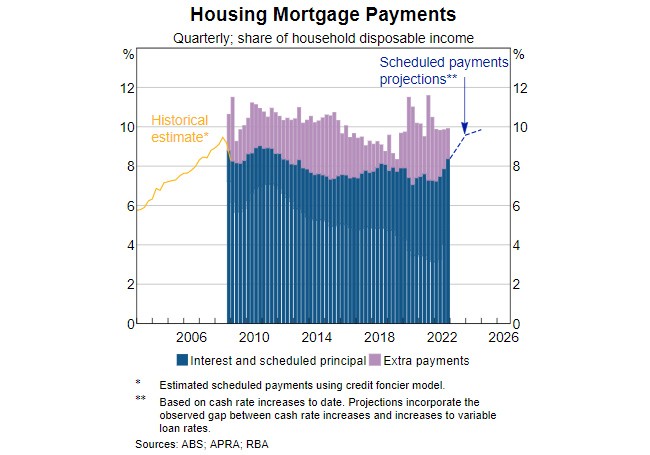
The second reason for a longer monetary policy lag is that the big run up in household savings during the pandemic means some borrowers have built up unusually large mortgage buffers. In fact, Australian households typically pay down their mortgages ahead of schedule, and over the pre-pandemic period, these payments averaged about two per cent of household disposable income. But during the pandemic, borrowers built up these buffers at an even faster rate, as for several quarters additional payments were as much as two percentage points above their historical average. As a result, the RBA estimates that if borrowers decided not to make any extra mortgage interest payments for a time, it would take around four quarters to erode the pandemic-era buffer. If borrowers choose to dip into these savings, they will be able to sustain spending despite higher interest rates and cost-of-living pressures.
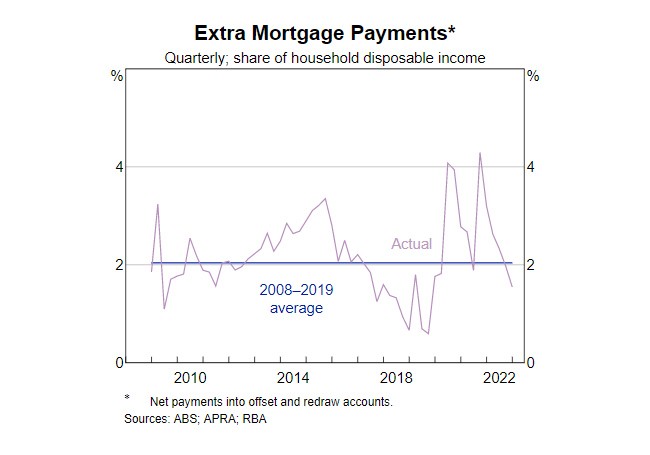
What else happened on the Australian data front this week?
The ANZ-Roy Morgan Consumer Confidence Index fell 0.5 points to an index reading of 76.5 last week. That kept the index below 80 for a third consecutive reading and marked the lowest result since early April 2020 and the onset of the pandemic. At the same time, weekly inflation expectations rose by 0.2 percentage points to 5.9 per cent – the highest rate reported since mid-December last year.
The ABS said household wealth fell $57.4 billion (0.4 per cent) over the December quarter 2022 to $14.4 trillion, or three per cent lower than in the corresponding quarter in 2021. The Bureau noted this was the third consecutive quarterly decline in household wealth. Non-financial assets owned by households declined by $213 billion (a two per cent drop), driven by a $232.9 billion fall in the value of land and dwellings reflecting weakness in the Australian housing market. This was partly offset by a $1919.5 billion rise in financial assets, led by a $120.1 billion increase in superannuation reserves.
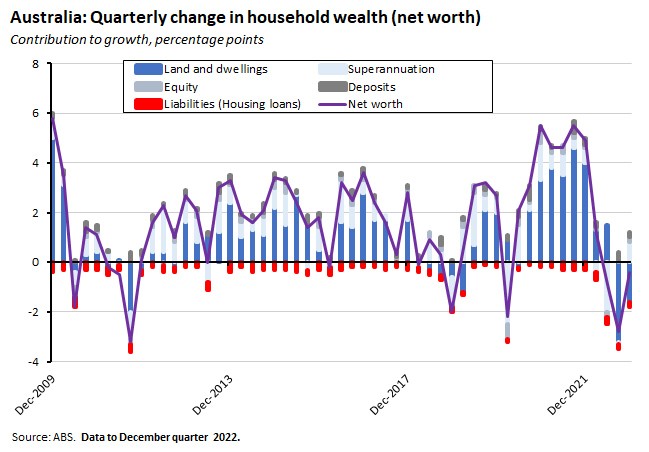
At the same time, household liabilities rose by $35.9 billion over the quarter, largely due to a $30.9 billion increase in housing loans.
Other things to note . . .
- The Productivity Commission (PC)’s new 5-year Productivity Inquiry report: Advancing Prosperity. This comprises a mammoth nine volumes and almost 1,000 pages, so digesting the contents will take some time. Meanwhile, one of the authors, PC Commissioner Stephen King, offers a brief take here.
- Grattan’s Tony Wood analyses the prospect of shortfalls for Australia’s east coast gas market.
- ACCC Chair Gina Cass-Gottlieb on opportunities and challenges in the digital revolution. ‘The scale and range of anti-competitive conduct occurring across digital platform services presents a real challenge for regulators. The competition and consumer harms we’ve uncovered are widespread, entrenched and systemic and cannot be addressed with enforcement action under current laws alone. We believe significant new measures are required.’
- A new RBA Research Discussion Paper analyses capital misallocation, investment and the productivity slowdown in Australia. It finds that the reallocation of capital to more productive firms in the Australian economy has slowed, with low-productivity firms now accounting for a larger share of total investment (while productive firms still tend to invest more than non-productive firms, the gap has narrowed). It also finds that the weaker relationship between firms’ investment and productivity was more evident in industries where competition appears to have fallen the most (suggesting lower competition may have weakened incentives to invest) and in industries where firms tend to be more dependent on debt financing (suggesting an increase in borrowing constraints).
- The Lowy Institute’s John Edwards considers limits on Australia’s submarine industry. Also from Lowy, Sam Roggeveen on distance, geography and Australian defence policy.
- ABC Business summarises Ken Henry’s views on Australia’s tax system and the case for reform covering intergenerational equity, the challenge of ‘capital shallowing’ prompted by the mining boom and the case for ‘big bang’ tax reform that should aim ‘to reduce the rate of tax applying to the normal return on capital while increasing the rate of tax applying to economic rents’.
- The March 2023 edition of the Australian Economic Review includes a policy forum assessing Australia’s fiscal policy response to COVID-19, with papers looking at cash transfer payments, gender gaps, JobKeeper, and COVID-19 Business Supports.
- John Freebairn analyses natural disasters and economic policy challenges.
- An e61 Institute research note on multi-employer bargaining cautions on the potential impact of recent government policy on firm growth and labour market competition.
- The OECD’s Interim Economic Outlook March 2023: A fragile recovery.
- Also from the OECD, the Science, Technology and Innovation Outlook 2023 and Job Creation and Local Economic Development 2023: Bridging the Great Green Divide.
- A WSJ long read on how higher interest rates caught up with banks.
- An FT ‘Big Read’ on the UBS takeover of Credit Suisse. And Martin Wolf on four ways to fix the bank problem.
- This IMF Chart of the Week captures a sharp fall in global holdings of portfolio assets due to a combination of lower investment (due to increased risk aversion) and valuation effects.
- A new BIS study on the inflation process, which argues it can be characterised by two regimes: low-inflation and high-inflation. In the former, measured inflation mostly reflects sector-specific price changes that are not closely correlated and where wages and prices are similarly only loosely linked with each other. As a result, inflation tends to be self-stabilising. In the latter, the common component of price changes is much more important, wages and prices are more tightly linked, and inflation is sensitive to changes in key prices including food and energy, as well as to changes in the exchange rate. In this high-inflation regime, the regime is self-entrenching. One key policy implication is that while monetary policy in low-inflation regimes can safely tolerate moderate yet persistent deviations from target, central banks need to be pre-emptive when the risk of transition to a high-inflation regime increases.
- The BIS also republished (from 2013) an in-depth primer on CoCos (contingent convertible capital instruments) which are in the news following events at Credit Suisse.
- Measuring (US) inflation: Market vs government or goods vs services?
- The Economist magazine’s A to Z of economics explains economic concepts from ‘absolute advantage’ to ‘zero-sum game’.
- The China Talk podcast had an interesting conversation with Nick Mulder about economic warfare spread over two episodes. The first episode covers the history of economic warfare and the use of sanctions as a tool during WW1 and the first half of the interwar period while the second looks at blockades and embargos in lead up to WW2 and lessons for current debates over decoupling and economic ‘containment’ strategies.
- The Australia in the World podcast discusses AUKUS and Australia-India relations.
Latest news
Already a member?
Login to view this content


